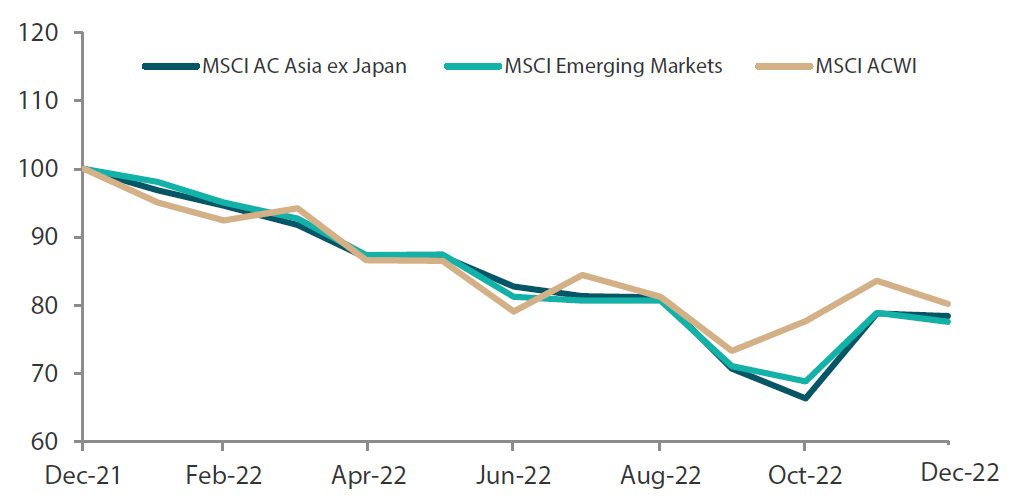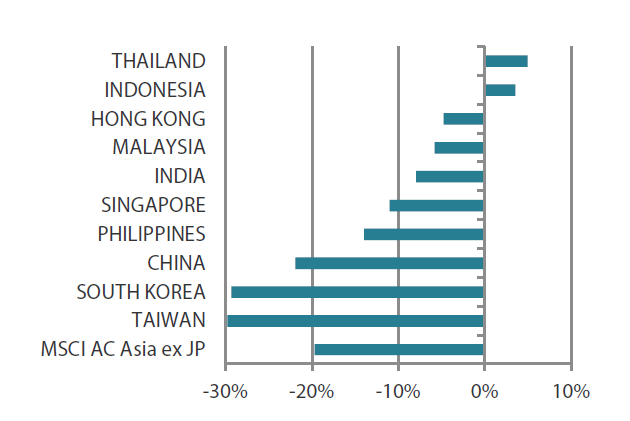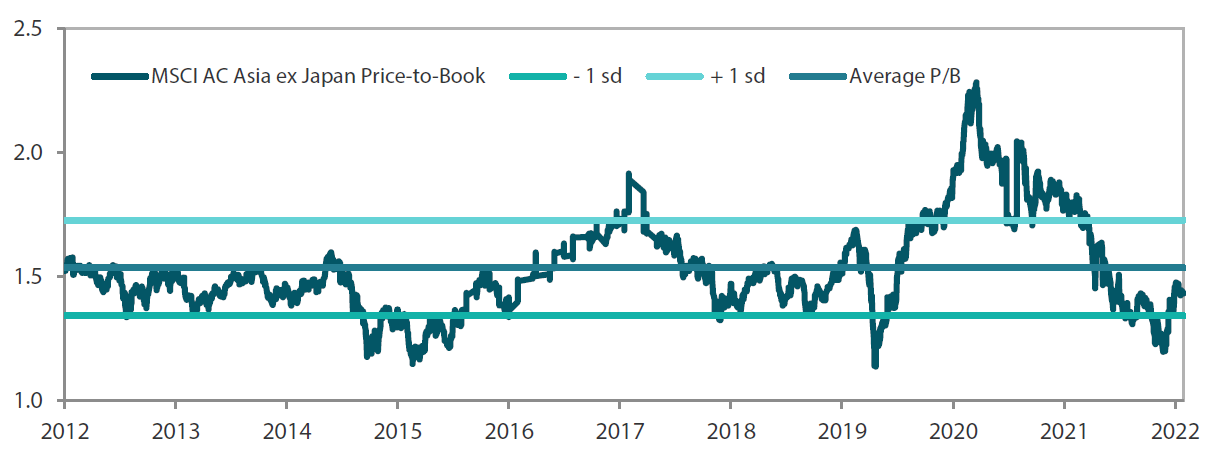Summary
- The MSCI AC Asia ex Japan Index was marginally lower in December, returning -0.2% in US dollar (USD) terms. The US Federal Reserve (Fed) delivered a widely anticipated 50 basis point rate hike, while China announced measures to ease COVID-19 restrictions.
- China jumped 5.2%, as it continued to pivot away from its zero-COVID policy. Hong Kong (+8.1%) was the region’s top performer, as it announced a planned border re-opening with China and a loosening of its domestic COVID-19 curbs. Elsewhere, Taiwan and South Korea slumped 5.5% and 5.2%, respectively, in December. The ASEAN region posted mixed returns for the month, while Indian equities retreated.
- In China, we prefer areas that are broadly aligned with the country’s strategic imperatives—energy security, greater self-sufficiency, improving cost of living and domestic consumption. We have a favourable view of banks and consumption plays in India. Renewable energy businesses and electric vehicle materials plus the related supply chains are areas we are most enthused by in the ASEAN region.
Market review
Asian markets declined marginally in December
The MSCI AC Asia ex Japan Index was marginally lower in December, returning -0.2% in US dollar terms. At the conclusion of its December policy meeting, the US Federal Reserve (Fed) delivered a widely anticipated 50 basis point rate hike and now expects the terminal rate to be at 5.1% in 2023, signalling its intention to tighten further in 2023. Elsewhere, China announced its decision to lift COVID-19 quarantine requirements on international arrivals in early January, taking one of its biggest steps to ease restrictions despite near-record case numbers.
Chart 1: 1-year market performance of MSCI AC Asia ex Japan versus Emerging Markets versus All Country World Index
 Source: Bloomberg, 31 December 2022. Returns are in USD. Past performance is not necessarily indicative of future performance.
Source: Bloomberg, 31 December 2022. Returns are in USD. Past performance is not necessarily indicative of future performance.
Chart 2: MSCI AC Asia ex Japan versus Emerging Markets versus All Country World Index price-to-earnings
 Source: Bloomberg, 31 December 2022. Returns are in USD. Past performance is not necessarily indicative of future performance.
Source: Bloomberg, 31 December 2022. Returns are in USD. Past performance is not necessarily indicative of future performance.
China and Hong Kong outperform, Taiwan and South Korea slump
In the North Asian region, China jumped 5.2% as it continued to pivot away from its zero-COVID policy. Initially, China rolled out 10 new measures to optimise its COVID-19 response, including allowing home quarantine for asymptomatic and mild cases. Later on, the Chinese government decided to re-open its borders and remove quarantine requirements for arrivals. On key economic data, China’s exports and imports both contracted at steeper paces in November due to softening external demand and a worsening COVID-19 outbreak disrupting production and reduce domestic demand. Hong Kong (+8.1%) was the region’s top performer, as it announced a planned border re-opening with China and a loosening of its domestic COVID-19 curbs.
Elsewhere, Taiwan and South Korea slumped 5.5% and 5.2% respectively in December. Taiwan’s exports slid 13.1% year-on-year (YoY) in November (more sharply than forecast) due to the worsening state of the global economy. Total exports of electronics components fell 4.9%, the first decline in three and a half years. South Korea saw factory activity shrink for a sixth consecutive month in December. The country’s exports also continued to decline on cooling global demand, falling 9.5% YoY. For the full year of 2022, exports rose 6.1%, while imports grew 18.9%, resulting in a record trade deficit of USD 47.2 billion.
Mixed performance for ASEAN markets
The ASEAN region posted mixed returns for the month. Thailand (+3.8%) led the region as one of the biggest beneficiaries of a potential return of Chinese tourists. Malaysia (+1.8%) saw moderate gains, whereas Singapore (-0.9%), the Philippines (-2.1%) and Indonesia (-4.5%) turned in losses in December.
Malaysia’s November headline consumer price index held steady at 4.0% YoY. Singapore saw November exports fall 14.6% from a year earlier, led by a weaker demand for electronics. Meanwhile, in December the central banks of the Philippines and Indonesia raised benchmark interest rates by 50 bps and 25 bps, respectively, as annual inflation rates continued on an upward trajectory.
Indian equities retreat
India retreated 5.5% in December. India's current account deficit widened during the July–September quarter, driven by high commodity prices and a weak rupee. The Reserve Bank of India hiked the key lending rate by 35 bps to 6.25% while lowering its GDP forecast to 6.8% for the fiscal year (2022–23). Other key economic data announced was India's retail inflation, which eased to an 11-month low of 5.88% in November.
Chart 3: MSCI AC Asia ex Japan Index1
| For the month ending 31 December 2022 | For the year ending 31 December 2022 | |

|

|
Source: Bloomberg, 31 December 2022.
1Note: Equity returns refer to MSCI indices quoted in USD. Returns are based on historical prices. Past performance is not necessarily indicative of future performance.
Market outlook
Inflation may not be detrimental to all Asian markets
There is an ongoing debate as to the stickiness of inflation and the economic pain the world needs to reckon with before signs of a recovery become visible. Asset markets appear preoccupied with guessing what the Fed itself is guessing—when will inflation ebb enough to hold/ease interest rates. With multiple policy inflections and valuations at depressed levels, we have been of the view that China is teeming with idiosyncratic opportunities and differentiated from the developed world. Given China is the largest driver of regional economic activities, we believe that Asia will also get a much-needed boost as a result.
Inflation, which is effectively a value transfer from net consumers to net producers, may continue to benefit India and pockets of ASEAN due to favourable demographics and rising productivity. Cheap and reliable energy is crucial for economic growth in the long run, particularly for big developing countries such as India and China, which can continue to buy cheap energy from Russia. In addition, most Asian economies have relatively young energy infrastructure that is increasingly going “green”. Accelerated infrastructure building is expected to raise productive capacity; it may also keep inflation in control if funded by fiscal deficits and foreign capital seeking higher returns than is available in developed markets.
Preferring areas that are broadly aligned with China’s strategic imperatives
It is worth noting that development and reforms continue to dominate the Chinese narrative—after all, the ruling party’s political legitimacy is reliant on economic development and improving the lives of its citizens. This is underscored by the recent easing of COVID-19 restrictions in response to unprecedented popular discontent. While China labour productivity has increased by 16% annually over the last 10 years, the country’s wage levels today are 20 times higher than they were in 1992, making automated assembly lines more compelling than in the past. A robot is seen to be virtually at cost parity with a human worker in China now. Thus, President Xi Jinping is focused on “high quality development” and the need to bolster capability and innovation, especially in areas critical to China’s national interests. For example, China aims to digitise 70% of manufacturing companies above a designated size. We prefer areas that are broadly aligned with these strategic imperatives—energy security, greater self-sufficiency, improving cost of living and domestic consumption.
President Xi also reiterated the desire for a “complete reunification of the Chinese nation”—a euphemism for China’s desire to take Taiwan back under its fold. If Russia’s invasion of Ukraine has taught us anything, it is to never completely discount such a possibility. Nonetheless, this is not our base case for the foreseeable future, where our concern is the demand headwinds affecting consumer technology, a mainstay of Taiwanese exports. This latter concern also extends to South Korea. The easing of Chinese COVID-related restrictions ought to benefit both countries—albeit offset to an extent by a slowdown in US demand. We find idiosyncratic opportunities in integrated circuit design, healthcare and energy infrastructure in these markets.
Favouring banks and consumption plays of India
India, the world’s fifth largest economy, is likely to enjoy political stability akin to the 1950s; Prime Minister Narendra Modi is expected to win a third term just as China’s President Xi recently did but for one small difference—India is the world’s largest democracy. Moreover, India has surpassed every nation, including China and the US, in digital financial transactions. This is extraordinary for a country which was heavily cash-reliant until just six years ago. Nearly a quarter of India’s energy is now green, with competitive renewable energy versus fossil fuel derived energy. The recently introduced Production Linked Incentive Scheme has seen active take-up and is attracting genuine investment into the country as part of global China+1 supply chain reconfigurations. We have a favourable view of banks and consumption plays in India.
Staying selective in ASEAN
The melodramatic Malaysian politics and the slightly more insipid version that is playing out in Thailand leave us wanting. Should things improve on this front, there are pockets in the technology and electric vehicle supply chain in these countries that could emerge as attractive. Singapore’s political stability is certainly a welcome change compared to the developments at its northern neighbours, but the majority of its equity market’s fortunes are reliant on economic developments around the region.
As such, Indonesia and, to a lesser extent, the Philippines appear in the limelight. It is worth noting that manufacturing does not exist in a vacuum; there is an entire supply chain tied to it. Reconfiguring an entire supply chain is therefore more than just building manufacturing capacity in a new location—it takes time. But once accomplished, it has a much larger impact on the economy that originally estimated. Indonesia is critical to the world electrifying transport owing to its nickel deposits. By focusing on a long-term vision, Indonesia has seen a 19-fold ramp-up in nickel exports in the past decade and has attracted battery making onshore and these projects have pulled in more than USD 25 billion in investments. Only 20% of the workforce in Indonesia is formally employed; the formalisation of its large workforce should improve economic productivity even as foreign capital seeks opportunities here.
The Philippines boasts a large, young and English-speaking population that is enjoying steadily improving access to financial services through digital means. By steadily increasing its reliance on locally developed “green” energy, the reliance on energy imports will likely decline from the current 2–3% of GDP.
Renewable energy businesses and electric vehicle materials plus the related supply chains are areas we are most enthused by in the ASEAN region.
Chart 4: MSCI AC Asia ex Japan price-to-earnings

Source: Bloomberg, 31 December 2022. Ratios are computed in USD. The horizontal lines represent the average (the middle line) and one standard deviation on either side of this average for the period shown. Past performance is not necessarily indicative of future performance.
Chart 5: MSCI AC Asia ex Japan price-to-book

Source: Bloomberg, 31 December 2022. Ratios are computed in USD. The horizontal lines represent the average (the middle line) and one standard deviation on either side of this average for the period shown. Past performance is not necessarily indicative of future performance.




